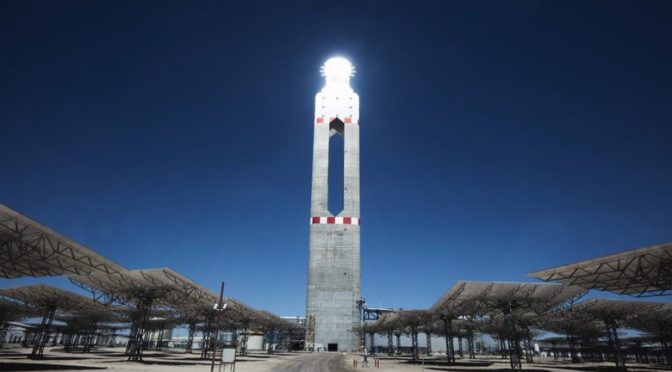In the Atacama Desert, the driest in the world located in northern Chile, the only Concentrated Solar Power tower in Latin America operates, a symbol of an energy revolution in the making against climate change.

Aerial view of Cerro Dominador, the first concentrated solar power plant in Latin America, in Antofagasta, Chile.
The imposing 240-meter construction is one of the pillars of the ambitious Chilean green energy program that began in 2019 and aims to completely replace fossil fuels by 2040.
Together with the concentrated solar power production of Cerro Dominador, which Chileans compare to Sauron’s tower from «The Lord of the Rings», the Alba Project is advancing, a pioneer in the world in the conversion of a coal-fired thermoelectric plant into a large storage system based on renewable energies.
Both facilities, the first in operation since 2021 and the second in its first phase of execution, are in Antofagasta, a region about 1,300 km north of Santiago.
«A decade ago, no one would have imagined that more than a third of Chile’s energy would come from the solar energy and wind power before 2030. It was seen as something ambitious and it has already been surpassed,» the former Environment Minister of Chile Marcelo Mena told AFP.
Today 35.4% of the energy generated in Chile is from wind energy and solar power, and 37.2% comes from water sources in the National Electric System (SEN), which covers the vast majority of demand. Oil, coal and gas represent 26.9%.
«Very few countries in the world have been able to truly consolidate a renewable energy industry like Chile,» highlights Marta Alonso, director for South America of GES (Global Energy Services), a global provider of services for the wind and solar industry.
However, after the strong initial push, the process lost pace due to the lack of legislation to change the energy matrix, adds the renewable energy expert.
Storage alternative
Perhaps one of the biggest obstacles in decarbonization is storage. All types of energy, if produced and not used, are lost, as if it were an open tap.
“It is a dilemma, because (storage) is not a mature technology yet,” says Alonso.
Chile has begun to explore an alternative that has already made its way in other parts of the world.
Both Cerro Dominador and the Alba Project are powered by so-called solar salts, also extracted from the Atacama Desert, composed of potassium nitrate and sodium nitrate, which, melted and kept in a liquid state, allow energy to be stored.
«The case of the Alba Project is unique in the world. “It is the only project that exists for Carnot batteries (thermal storage) of that magnitude outside of a university,” explains Diego Pardow, Chilean Minister of Energy.
«Our projection is that as coal plants are eliminated» they will be replaced by concentrated solar power plants and by «the conversion of these plants to batteries like the Alba Project,» he adds.
In this way, Chile moves forward in the fight against the climate crisis in Latin America, one of the regions that emits the least CO2 in the world, according to experts.
From coal to solar salt
The Cerro Dominador tower is surrounded by 10,600 mirrors or heliostats that form a kind of sunflower at its feet. It is the fourth plant of this type in the world and the only one in Latin America.

The promising solar salts circulate through artery-like ducts that connect to the tip of the structure, where mirrors that reflect sunlight heat them up to 565ºC.
Then, they go down those same pipes to water containers that generate the steam that moves the turbine, which in turn produces electricity. The plant has an installed capacity of 110 megawatts (MW).
«Thanks to the salts we managed to have a storage of 17 hours,» explains Iván Abella, Corporate Construction manager of the Cerro Group.
Therefore, when “we stop having the source of energy, the sun, we have stored it in a tank with salts,” he adds.
The Alba project also aims to use the same technology to transform the modern Angamos coal-fired thermoelectric plant, owned by AES, which began operating in 2011.
«Maintaining half of the assets of this plant, which is practically new, (Angamos) would be transformed into a battery, which would use renewable electrical energy,» says Vanni Boggio, manager of the North Complex of AES Chile.
Alba will be supplied with photovoltaic and wind energy, which in turn will heat the salts that will replace the fossil fuels with which they operate today, to maintain its current power of 560 MW.
Alba «is a very interesting project (…) We have to follow it closely because it could be a solution» although it is not a panacea, the GES analyst clarifies.


